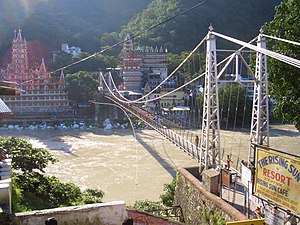Lakshman Jhula

Lakshman Jhula is a suspension bridge across the river Ganges, located 5 kilometres (3 mi) north-east of the city of Rishikesh in the Indian state of Uttarakhand. The bridge connects the two villages of Tapovan in Tehri Garhwal district, on the west bank of the river, to Jonk in Pauri Garhwal district, on the east bank. Lakshman Jhula is a pedestrian bridge that was also used by motorbikes. Despite its location on the outskirts of the city, it is one of the iconic landmarks of Rishikesh. A larger bridge 2 kilometres (1.2 mi) downstream from Lakshman Jhula is Ram Jhula.
As of November 5th, 2020, this bridge is restricted to pedestrian access and is set to be closed permanently when a replacement bridge is built parallel to it. Barriers on both sides prevent vehicular traffic including motorcycles and scooters. However, pedestrian access is still possible and has been confirmed by observers on the ground. Media reports of the bridge being completely closed are not accurate at this time. The bridge is being replaced due to its deteriorating condition. Please see news reports for the latest developments. The bridge is closed for vehicles be it 2 wheelers or 4 wheelers but open for pedestrians.
It is said that the Hindu deity Lakshmana crossed the Ganges on jute ropes where the bridge is built.[1] Lakshman Jhula was completed in 1929.[2]
Two plaques exist at the foot of the west side of the bridge.
The first plaque reads:
Lakshman Jhula Bridge
First Jeepable Suspension Bridge of U.P.
Span - 450 feet
Carriage Way - 6 feet
This bridge was constructed by U.P.P.W.D. during 1927-1929. It replaces the old bridge of 284 feet span which was washed away by great floods of October, 1924. This was opened to traffic on 11 April 1930.
Officers / Officials responsible include:
1. Chief Engineer - P. H. Tillard
2. Superintending Engineer - E. H. Cornelius
3. Executive Engineer - C. F. Hunter
4. Assistant Engineers - Jagdish Prasad, Avadh Narain
5. Overseer - Bala Ram
The second plaque reads:
Lakshman Jhuala Suspension Bridge
Span - 450 feet
Height of roadway above mean summer water level - 59 feet
Opened to traffic by H.E. Sir Malcolm Haley C.C.I.E. K.C.S.I. Governor of the United Provinces on 11 April 1930. This bridge was constructed by the Public Works Department during the years 1927-1929. It replaces the old bridge of 284 feet span, which was the gift of Rai Bahadur Surajmal Jhunjhunwala father of Rai Bahadur Shewpershad Tulshan, and was situated about 200 feet down stream. This was washed away by the great flood of October, 1924 which undermined the left abutment. The extra cost of rebuilding this new bridge as nearly as possible on the site of the old bridge has been contributed by Rai Bahadur Shewpershad Tulshan to perpetuate the honored memory of his father and no toll or tax will ever be imposed or realized for crossing this bridge.
Gallery
-
A view of the bridge.
-
the bridge and area before major commercial development
References
- ^ Kohli, M.S. (2002). Mountains of India: Tourism, Adventure and Pilgrimage. New Delhi: Indus Publishing Company. p. 316. ISBN 81-7387-135-3.
- ^ "Lakshman Jhula". India9.com. Retrieved 20 July 2009.
30°7′34.9″N 78°19′47.6″E / 30.126361°N 78.329889°E




